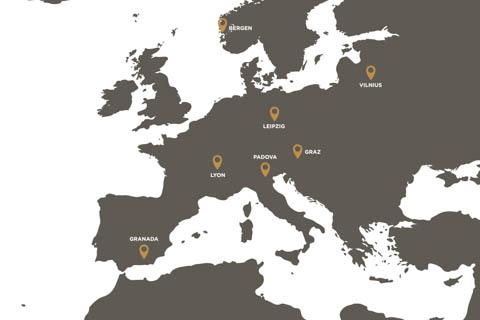 |
Faculty
Faculty of Physics |
|

|
Scope of studies and length
120 ECTS credits, 2 years |
|

|
Qualification awarded
Master in Physical Sciences |
|

|
Application deadline*
1 May / 1 July |
|

|
Language
English |
|

|
Tuition fee per year
6 500 € for non-EU students
5 538 € for EU students |
|

|
Start of studies
1 September
|
 |
City
Vilnius |
APPLY NOW
During the four semesters of their studies, students will have hands-on instruction in parallel computing methods for scientific applications, computational optimisation approaches and artificial intelligence as compulsory courses. In addition, they can choose from a range of theoretical physics and astrophysics courses, which include mathematical modelling, non-local mathematical physics, physical kinetics, spectrometry, data mining, star atmospheres, advanced statistical physics, response theory, cosmology, quantum theory of atoms and molecules, quantum information, low-temperature physics, quantum thermodynamics and the physics of galaxies. For, every semester students join research groups for practice and for gaining experience in research.
Programme structure
| Subjects of study |
Credits |
|
Semester 1 Autumn |
| Compulsory Courses |
15.0 |
| Nonlocal Mathematical Physics |
5.0 |
| Scientific Research Work I/III p. |
10.0 |
| Optional Courses |
15.0 |
| Atmosphere of Stars |
5.0 |
| Data Analysis Methods |
5.0 |
| Evoliution of Stars |
5.0 |
| Modelling of Stochastic Processes |
5.0 |
| Numerical Models of Physical Kinetics |
5.0 |
| Quantum Field Theory I/II p. |
5.0 |
|
Semester 2 Spring |
| Compulsory Courses |
15.0 |
| Research Project II (Scientific research project II/III) |
10.0 |
| Theory of Atoms |
5.0 |
| Optional Courses |
15.0 |
| Astrobiology |
5.0 |
| Astrospectroscopic Instruments and Methods |
5.0 |
| Concepts of Molecular Modeling |
5.0 |
| Physics of Galaxies |
5.0 |
| Quantum Field Theory II/II p. |
5.0 |
| Quantum Information and Cryptography |
5.0 |
| Quantum Statistical Physics |
5.0 |
| Solid State Theory |
5.0 |
|
Semester 3 Autumn |
| Compulsory Courses |
15.0 |
| Research Project 3 (Scientific research project III/III) |
15.0 |
| Optional Courses |
15.0 |
| Analysis of Astrospectroscopic Data |
5.0 |
| Artificial Intelligence |
5.0 |
| Classical and Quantum Molecular Dynamics |
5.0 |
| Cosmology |
5.0 |
| Low Temperature Physics |
5.0 |
| Non-equilibrium Statistical Physics |
5.0 |
| Open Problems in Astrophysics |
5.0 |
| Selected Topics in Astrophysics |
5.0 |
|
Semester 4 Spring |
| Compulsory Courses |
30.0 |
| Master Final Thesis (Study field: Physics) |
30.0 |
Key Learning Outcomes
Graduates will become highly qualified international-level specialists.
- They will be capable of planning original research projects and carrying them out within interdisciplinary teams.
- They will know how to conduct research in astronomy, electrodynamics, and quantum theory of micro-objects, using IT, and solve both theoretical and applied physics problems.
Programme Specific Requirements
- Completed university Bachelor’s degree studies in Physics field of the Physical Sciences study field group or Materials Technology of the Technological Sciences study field group or other studies closely related to the aforementioned fields.
- The arithmetical average of the learning outcomes of the course units in the fields of Physics, Mathematics, Chemistry, Materials Technology, Computing shall be no less than 60 per cent of the maximum possible grade; All course units must be passed (positively assessed).
- Additional points shall be awarded for scientific publications supported by bibliographic links and presentations in scientific conferences in the fields related with the study programme.
- The candidates meeting the aforementioned criteria are invited to the remote motivational interview. During the interview, the candidate’s determination to study in a master’s degree programme based on science is evaluated. If the interview is evaluated negatively, the candidate is not admitted to the study programme.
In addition, all applicants have to fulfil the general admission requirements.
Why choose this programme?
-
This is the only programme at the Faculty of Physics in which students begin their research activities from the first semester.
-
Programme is ideally suited for those interested in astrophysics, particle physics, and molecular physics. Students gain access to international research environments — including internship opportunities at CERN, European Space Agency, and others.
-
The programme fosters strong competencies in programming, mathematics, and data analysis. Students use modern parallel computing technologies and supercomputing infrastructure, while also exploring the frontiers of quantum computing.
-
The curriculum emphasizes interdisciplinarity and flexibility: students can tailor their studies by either engaging broadly across multiple fields of physics or specializing deeply in one.
-
It is designed to prepare specialists capable of addressing multiscale supercomputing challenges with original and creative thinking, reinforced by theoretical tools drawn from modern physics.
|
What comes after?
- Graduates can work in research, theoretical forecasting, information management and computer modelling, in research or high-tech companies.
|


